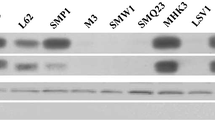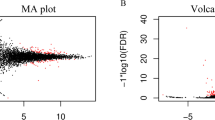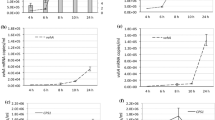Abstract
Vibrio parahaemolyticus possesses two distinct type VI secretion systems (T6SS), namely T6SS1 and T6SS2. T6SS1 is predominantly responsible for adhesion to Caco-2 and HeLa cells and for the antibacterial activity of V. parahaemolyticus, while T6SS2 mainly contributes to HeLa cell adhesion. However, it remains unclear whether the T6SS systems have other physiological roles in V. parahaemolyticus. In this study, we demonstrated that the deletion of icmF2, a structural gene of T6SS2, reduced the biofilm formation capacity of V. parahaemolyticus under low salt conditions, which was also influenced by the incubation time. Nonetheless, the deletion of icmF2 did not affect the biofilm formation capacity in marine-like growth conditions, nor did it impact the flagella-driven swimming and swarming motility of V. parahaemolyticus. IcmF2 was found to promote the production of the main components of the biofilm matrix, including extracellular DNA (eDNA) and extracellular proteins, and cyclic di-GMP (c-di-GMP) in V. parahaemolyticus. Additionally, IcmF2 positively influenced the transcription of cpsA, mfpA, and several genes involved in c-di-GMP metabolism, including scrJ, scrL, vopY, tpdA, gefA, and scrG. Conversely, the transcription of scrA was negatively impacted by IcmF2. Therefore, IcmF2-dependent biofilm formation was mediated through its effects on the production of eDNA, extracellular proteins, and c-di-GMP, as well as its impact on the transcription of cpsA, mfpA, and genes associated with c-di-GMP metabolism. This study confirmed new physiological roles for IcmF2 in promoting biofilm formation and c-di-GMP production in V. parahaemolyticus.





Similar content being viewed by others
Data availability
All relevant data are within the manuscript.
References
Boles BR, McCarter LL (2002) Vibrio parahaemolyticus scrABC, a novel operon affecting swarming and capsular polysaccharide regulation. J Bacteriol 184:5946–5954. https://doi.org/10.1128/jb.184.21.5946-5954.2002
Chen L et al (2023) AphA directly activates the transcription of polysaccharide biosynthesis gene scvE in Vibrio parahaemolyticus. Gene 851:146980. https://doi.org/10.1016/j.gene.2022.146980
Coulthurst SJ (2013) The type VI secretion system - a widespread and versatile cell targeting system. Res Microbiol 164:640–654. https://doi.org/10.1016/j.resmic.2013.03.017
Das S, Chakrabortty A, Banerjee R, Chaudhuri K (2002) Involvement of in vivo induced icmF gene of Vibrio cholerae in motility, adherence to epithelial cells, and conjugation frequency. Biochem Biophys Res Commun 295:922–928. https://doi.org/10.1016/s0006-291x(02)00782-9
de Pace F et al (2011) Characterization of IcmF of the type VI secretion system in an avian pathogenic Escherichia coli (APEC) strain. Microbiol (Reading) 157:2954–2962. https://doi.org/10.1099/mic.0.050005-0
Enos-Berlage JL, Guvener ZT, Keenan CE, McCarter LL (2005) Genetic determinants of biofilm development of opaque and translucent Vibrio parahaemolyticus. Mol Microbiol 55:1160–1182. https://doi.org/10.1111/j.1365-2958.2004.04453.x
Flemming HC, Wingender J (2010) The biofilm matrix. Nat Rev Microbiol 8:623–633. https://doi.org/10.1038/nrmicro2415
Gallique M, Bouteiller M, Merieau A (2017a) The type VI Secretion System: a dynamic system for bacterial communication? Front Microbiol 8:1454. https://doi.org/10.3389/fmicb.2017.01454
Gallique M et al (2017b) Contribution of the Pseudomonas fluorescens MFE01 type VI Secretion System to Biofilm formation. PLoS ONE 12:e0170770. https://doi.org/10.1371/journal.pone.0170770
Gao H et al (2011) Regulatory effects of cAMP receptor protein (CRP) on porin genes and its own gene in Yersinia pestis. BMC Microbiol 11:40. https://doi.org/10.1186/1471-2180-11-40
Hespanhol JT, Nóbrega-Silva L, Bayer-Santos E (2023) Regulation of type VI secretion systems at the transcriptional, posttranscriptional and posttranslational level. Microbiol (Reading) 169. https://doi.org/10.1099/mic.0.001376
Homma M, Kojima S (2022) Roles of the second messenger c-di-GMP in bacteria: focusing on the topics of flagellar regulation and Vibrio Spp. Genes Cells 27:157–172. https://doi.org/10.1111/gtc.12921
Kim YK, McCarter LL (2007) ScrG, a GGDEF-EAL protein, participates in regulating swarming and sticking in Vibrio parahaemolyticus. J Bacteriol 189:4094–4107. https://doi.org/10.1128/jb.01510-06
Kimbrough JH, McCarter LL (2021) Identification of three New GGDEF and EAL Domain-containing proteins participating in the Scr Surface Colonization Regulatory Network in Vibrio parahaemolyticus. J Bacteriol 203. https://doi.org/10.1128/jb.00409-20
Li P et al (2017) Acute Hepatopancreatic Necrosis Disease-Causing Vibrio parahaemolyticus strains maintain an antibacterial type VI Secretion System with Versatile Effector repertoires. Appl Environ Microbiol 83. https://doi.org/10.1128/aem.00737-17
Li W et al (2020) Insights into the role of extracellular DNA and extracellular proteins in Biofilm formation of Vibrio parahaemolyticus. 11. https://doi.org/10.3389/fmicb.2020.00813
Li X et al (2021) The Effect of Salinity on Biofilm formation and c-di-GMP production in Vibrio parahaemolyticus. Curr Microbiol 79:25. https://doi.org/10.1007/s00284-021-02723-2
Li X et al (2024) Environmental magnesium ion affects global gene expression, motility, biofilm formation and virulence of Vibrio parahaemolyticus. Biofilm 7:100194. https://doi.org/10.1016/j.bioflm.2024.100194
Liu M, Nie H, Luo X, Yang S, Chen H, Cai P (2022) A polysaccharide biosynthesis locus in Vibrio parahaemolyticus important for Biofilm formation has Homologs widely distributed in aquatic Bacteria mainly from Gammaproteobacteria. mSystems 7:e0122621. https://doi.org/10.1128/msystems.01226-21
Lu R, Osei-Adjei G, Huang X, Zhang Y (2018) Role and regulation of the orphan AphA protein of quorum sensing in pathogenic Vibrios. Future Microbiol 13:383–391. https://doi.org/10.2217/fmb-2017-0165
Lu R et al (2019) Quorum sensing regulates the transcription of lateral flagellar genes in Vibrio parahaemolyticus. Future Microbiol 14:1043–1053. https://doi.org/10.2217/fmb-2019-0048
Ma LS, Lin JS, Lai EM (2009) An IcmF family protein, ImpLM, is an integral inner membrane protein interacting with ImpKL, and its walker a motif is required for type VI secretion system-mediated hcp secretion in Agrobacterium tumefaciens. J Bacteriol 191:4316–4329. https://doi.org/10.1128/jb.00029-09
Ma L et al (2012) Expression of the type VI secretion system 1 component Hcp1 is indirectly repressed by OpaR in Vibrio parahaemolyticus. ScientificWorldJournal 2012:982140. https://doi.org/10.1100/2012/982140
Makino K et al (2003) Genome sequence of Vibrio parahaemolyticus: a pathogenic mechanism distinct from that of V cholerae. Lancet 361:743–749. https://doi.org/10.1016/s0140-6736(03)12659-1
Martínez-Méndez R, Camacho-Hernández DA, Sulvarán-Guel E, Zamorano-Sánchez D (2021) A trigger phosphodiesterase modulates the global c-di-GMP Pool, Motility, and Biofilm formation in Vibrio parahaemolyticus. J Bacteriol 203:e0004621. https://doi.org/10.1128/jb.00046-21
Mougous JD et al (2006) A virulence locus of Pseudomonas aeruginosa encodes a protein secretion apparatus. Science 312:1526–1530. https://doi.org/10.1126/science.1128393
Park S, Sauer K (2022) Controlling Biofilm Development through cyclic di-GMP Signaling. Adv Exp Med Biol 1386:69–94. https://doi.org/10.1007/978-3-031-08491-1_3
Pukatzki S et al (2006) Identification of a conserved bacterial protein secretion system in Vibrio cholerae using the Dictyostelium host model system. Proc Natl Acad Sci U S A 103:1528–1533. https://doi.org/10.1073/pnas.0510322103
Römling U, Galperin MY, Gomelsky M (2013) Cyclic di-GMP: the first 25 years of a universal bacterial second messenger. Microbiol Mol Biol Rev 77:1–52. https://doi.org/10.1128/mmbr.00043-12
Salomon D, Gonzalez H, Updegraff BL, Orth K (2013) Vibrio parahaemolyticus type VI secretion system 1 is activated in marine conditions to target bacteria, and is differentially regulated from system 2. PLoS ONE 8:e61086. https://doi.org/10.1371/journal.pone.0061086
Sana TG et al (2016) Salmonella Typhimurium utilizes a T6SS-mediated antibacterial weapon to establish in the host gut. Proc Natl Acad Sci U S A 113:E5044–5051. https://doi.org/10.1073/pnas.1608858113
Sengupta C, Mukherjee O, Chowdhury R (2016) Adherence to Intestinal Cells Promotes Biofilm Formation in Vibrio cholerae. The Journal of Infectious Diseases 214:1571–1578 The Journal of Infectious Diseases
Sharan M, Vijay D, Dhaka P, Bedi JS, Gill JPS (2022) Biofilms as a microbial hazard in the food industry: a sco** review. J Appl Microbiol 133:2210–2234. https://doi.org/10.1111/jam.15766
Silverman JM, Brunet YR, Cascales E, Mougous JD (2012) Structure and regulation of the type VI secretion system. Annu Rev Microbiol 66:453–472. https://doi.org/10.1146/annurev-micro-121809-151619
Sun F et al (2014) H-NS is a repressor of major virulence gene loci in Vibrio parahaemolyticus. Front Microbiol 5:675. https://doi.org/10.3389/fmicb.2014.00675
Wang T et al (2015) Type VI Secretion System transports Zn2 + to Combat multiple stresses and host immunity. PLoS Pathog 11:e1005020. https://doi.org/10.1371/journal.ppat.1005020
Whitaker WB, Parent MA, Naughton LM, Richards GP, Blumerman SL, Boyd EF (2010) Modulation of responses of Vibrio parahaemolyticus O3:K6 to pH and temperature stresses by growth at different salt concentrations. Appl Environ Microbiol 76:4720–4729. https://doi.org/10.1128/aem.00474-10
Wu Q et al (2022) Transcriptomic Analysis of Vibrio parahaemolyticus underlying the wrinkly and smooth phenotypes. Microbiol Spectr 10:e0218822. https://doi.org/10.1128/spectrum.02188-22
Wu X et al (2023) Destruction of self-derived PAMP via T3SS2 effector VopY to subvert PAMP-triggered immunity mediates Vibrio parahaemolyticus pathogenicity. Cell Rep 42:113261. https://doi.org/10.1016/j.celrep.2023.113261
Yildiz FH, Visick KL (2009) Vibrio biofilms: so much the same yet so different. Trends Microbiol 17:109–118. https://doi.org/10.1016/j.tim.2008.12.004
Yu Y et al (2012) Putative type VI secretion systems of Vibrio parahaemolyticus contribute to adhesion to cultured cell monolayers. Arch Microbiol 194:827–835. https://doi.org/10.1007/s00203-012-0816-z
Yu Y, Fang L, Zhang Y, Sheng H, Fang W (2015) VgrG2 of type VI secretion system 2 of Vibrio parahaemolyticus induces autophagy in macrophages. Front Microbiol 6:168. https://doi.org/10.3389/fmicb.2015.00168
Zhang Y, Qiu Y, Tan Y, Guo Z, Yang R, Zhou D (2012) Transcriptional regulation of opaR, qrr2-4 and aphA by the master quorum-sensing regulator OpaR in Vibrio parahaemolyticus. PLoS ONE 7:e34622. https://doi.org/10.1371/journal.pone.0034622
Zhang Y et al (2017) Transcriptional regulation of the type VI Secretion System 1 genes by Quorum Sensing and ToxR in Vibrio parahaemolyticus. Front Microbiol 8:2005. https://doi.org/10.3389/fmicb.2017.02005
Zhang Y et al (2021) OpaR controls the metabolism of c-di-GMP in Vibrio parahaemolyticus. Front Microbiol 12:676436. https://doi.org/10.3389/fmicb.2021.676436
Zhang M et al (2023a) Effect of sublethal dose of chloramphenicol on biofilm formation and virulence in Vibrio parahaemolyticus. Front Microbiol 14:1275441. https://doi.org/10.3389/fmicb.2023.1275441
Zhang M et al (2023b) L-arabinose affects the growth, biofilm formation, motility, c-di-GMP metabolism, and global gene expression of Vibrio parahaemolyticus. J Bacteriol 205:e0010023. https://doi.org/10.1128/jb.00100-23
Zhang M et al (2023c) QsvR represses the transcription of polar flagellum genes in Vibrio parahaemolyticus. Microb Pathog 174:105947. https://doi.org/10.1016/j.micpath.2022.105947
Zhang M et al (2023d) QsvR and OpaR coordinately repress biofilm formation by Vibrio parahaemolyticus. Front Microbiol 14:1079653. https://doi.org/10.3389/fmicb.2023.1079653
Zhang Y et al (2023e) Quorum sensing and QsvR tightly control the transcription of vpa0607 encoding an active RNase II-type protein in Vibrio parahaemolyticus. Front Microbiol 14:1123524. https://doi.org/10.3389/fmicb.2023.1123524
Zhang Y et al (2023f) Transcriptomic profiles of Vibrio parahaemolyticus during Biofilm formation. Curr Microbiol 80:371. https://doi.org/10.1007/s00284-023-03425-7
Zhong X, Lu Z, Wang F, Yao N, Shi M, Yang M (2022) Characterization of GefA, a GGEEF domain-containing protein that modulates Vibrio parahaemolyticus Motility, Biofilm formation, and virulence. Appl Environ Microbiol 88:e0223921. https://doi.org/10.1128/aem.02239-21
Zhu W et al (2023) Identification of VP0143 gene which modulates biofilm formation of Vibrio parahaemolyticus. Food Bioscience 56:103271. https://doi.org/10.1016/j.fbio.2023.103271
Acknowledgements
This work was supported by the Special Project on Clinical Medicine of Nantong University (2023JQ011 and 2023JQ017) and the Research Project of Nantong Health Commission (QN2023032).
Author information
Authors and Affiliations
Contributions
Q Huang, M Zhang, X Li and X Luo performed the laboratory experiments. S Ji, Y Zhang and R Lu designed and supervised the experiments. Q Huang and Y Zhang wrote the manuscript. Q Huang, M Zhang and X Li received the financial support. All authors read and approved the final manuscript.
Corresponding authors
Ethics declarations
Competing interests
The authors declare no competing interests.
Additional information
Communicated by Yusuf Akhter.
Publisher’s Note
Springer Nature remains neutral with regard to jurisdictional claims in published maps and institutional affiliations.
Rights and permissions
Springer Nature or its licensor (e.g. a society or other partner) holds exclusive rights to this article under a publishing agreement with the author(s) or other rightsholder(s); author self-archiving of the accepted manuscript version of this article is solely governed by the terms of such publishing agreement and applicable law.
About this article
Cite this article
Huang, Q., Zhang, M., Zhang, Y. et al. IcmF2 of the type VI secretion system 2 plays a role in biofilm formation of Vibrio parahaemolyticus. Arch Microbiol 206, 321 (2024). https://doi.org/10.1007/s00203-024-04060-x
Received:
Revised:
Accepted:
Published:
DOI: https://doi.org/10.1007/s00203-024-04060-x




